Another so so day, with clouds free wheeling across the sky. Another couple of opportunities to catch a bright flare with Mars and Saturn. The first one came around, so all set with the SatCatcher and I took a shot, but only caught bands of clouds. ABout 20 minutes later, the second opportunity came along. I tried again, and this time, finally, I got a nice bright mag -5 flare, with Mars and Saturn in the frame. Phew.
Iridium 29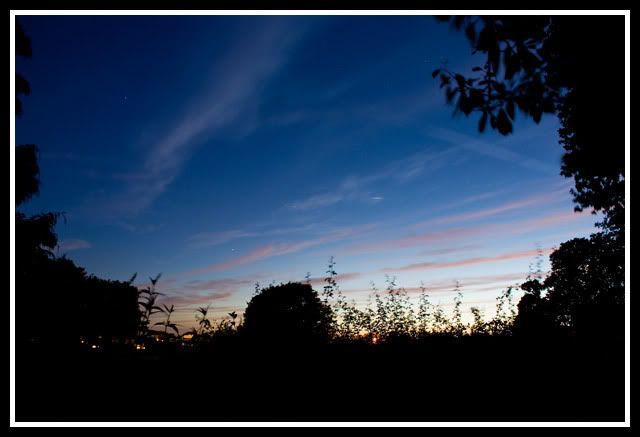
Having taken this shot. And fought with the clouds enough, I came in to process it, and after some advice on a forum, had another go at processing the output from stacking the Cygnus region widefield from the other day. I found a couple of interesting little tricks that certainly enhanced the image, and also discovered that my original from the other day had been over processed in removing light pollution, removing star detail in the process. Anyway, after a number of passes trying different things, I ended up with :
Monday, 30 June 2008
Flare and planets
Sunday, 29 June 2008
Early morning moon
I remembered a few minutes ago, I'm pretty tired, so please excuse me, serves me right for taking astro shots at the time I was doing last night, that I'd taken a few pics of the moon hanging low in the Easter sky. Here's the best one:
I might have a try at taking a sequence of these and stacking them...
Flare, Stars and Planet
A reasonable day, weather wise yesterday and a night, that's actually quite clear. Checked on HA and yes, we have a mag -6 flare forecast to pass just over Saturn and Mars. I got everything setup on the SatCatcher, but for some reason, I could not get the camera to focus. I thought I had 4 minutes longer than I did, and ended up, getting the focus about right, after the flare had passed. I'm a bit fed up about that. First time in a week, the sky has been clear to catch it and I missed it. I took a shot anyway showing the sunset with Saturn and Mars.
There were some odd clouds passing over, thin, quite high and looking like sand dunes in the night, so I took a picture of them.
About an hour later, I started setting up for the next flare. I was still having trouble with focusing as I'd left the lens on manual mode, and when I'd put the lens cap back on, had moved focus. It's gonna be one of those nights. I took a few test shots, and got the focus right. As I was shooting the last one, the flare appeared. Typical. Once the 6 second test shot had finished, I quickly set for 30 seconds and snapped again. I stacked the pair of images in DSS, and used Noels tools to remove the LP. It's not the best flare ever, and I might try adding the line back in, or maybe just keep it like this as a reminder to prepare earlier.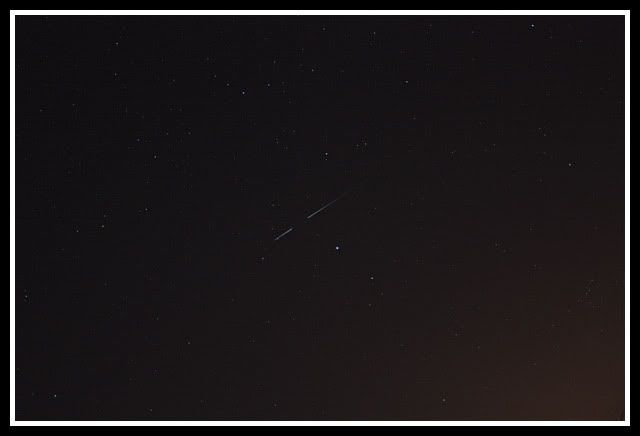
After this, I set the camera back up on the tripod, and using a feature I'd found in the manual, yes that's not something I normally do, the self timer can be set for 10 seconds, and take 10 exposures. I set about taking a bunch of frames of widefield views. Firstly the area around Arcturus. Something didn't quite go right during the stacking, there was some blurring along the edge of the shot, so the result has been cropped.
30 x 30 seconds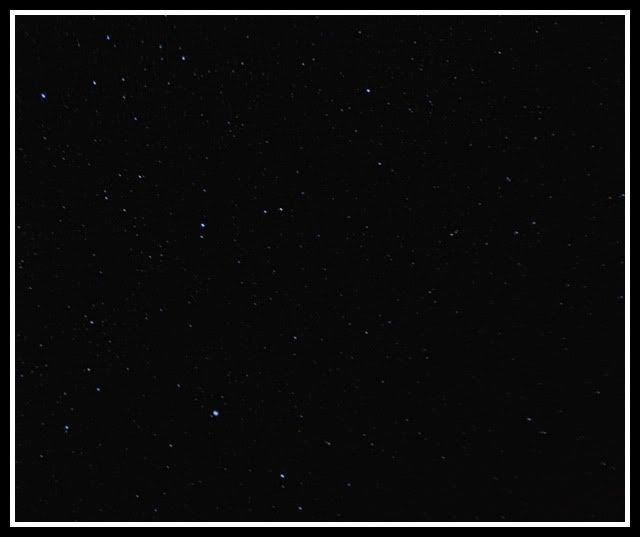
As the streelights out the front had now gone off, I transferred everything to the front of the house, this time taking my bins with me. I set up and started the same process with the self timer, pointing at the region of cygnus (I think). Whilst the camera was snapping away I had a look around the milky way with the bins and got totally lost in the starscapes unveiling before me. Serious wow factor. I also took a look at Jupiter, and I was quite surprised to make out the Galilean moons in the bins. After the third set of 10 frames, the clouds had shifted back in and only 28 of them were usable. These to were stacked in DSS and similar processing resulted in: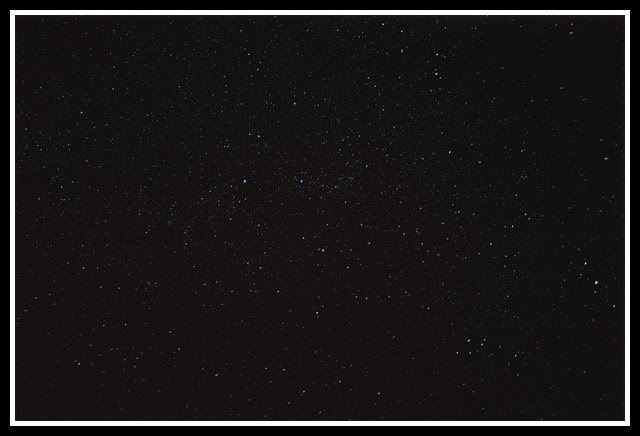
I then swapped lenses to the 55-250 and zoomed in on the mighty one. I took a series of shots, and this is the best
In order from left to right we have :
Callisto, Ganymede, Europa, Io, Jupiter and a guest appearance by HP 95077 (mag 5.5 star 186 LY away).
And then as I bought everything in and went to download the widefield shots, I realised once again that I'd forgottten to take any dark frames. Ah well, I'll get it right one of these nights.
Friday, 27 June 2008
No flares, Jupiter moon project, No stars
For once the weather forecasters managed to make an accurate prediction. The day had been a bit hit and miss, with a mix of clouds and sun. By the early evening, there was some thin high cloud but plenty of open sky too and the cloud was thin enough to not be a problem. I was out for a while doing family things, and as we left, the sky had disappeared behind a layer of thick grey. On the way home it started to rain. I was a bit put out about this as I'd been hoping for at least 2 flares around 2230 last night. A mah -7 and mag -6, both within 15 minutes of each other, both flying within camera eyes view of Saturn and Mars. Of course, the possible project for Jupiter's moons, cacpturing daily shots and showing the motion also went out the window. I can only assume that someone has it in for me to prevent me capturing a bright flare and a couple of planets in the same shot.
Thursday, 26 June 2008
The Sky, It's full of stars
A very clear night last night, but I'd agreed to help a friend out with their computer. A flare was set to appear, and we both popped out to take a look (no camera or SatCatcher). We didn't see the flare, but did see a couple of other satellites and I realised exactly how clear the night was by looking up. After a quick look around, pointing out a few of the sights, we went back to finish of the computer. I eventually got home just after midnight. The County Council turns off most of the streetlights after midnight to save power. Looking up, I could clearly see the band of the milky way running across the stars. Of course, I dashed in side and grabbed the camera and tripod. I snapped away, grabbing some 19x30 second frames. I was a little concerned as I was standing on my drive overlooking the road, but all was fine. After stacking in DSS (it worked this time) and processing with Noel's LP tool, sharpening etc, this is the result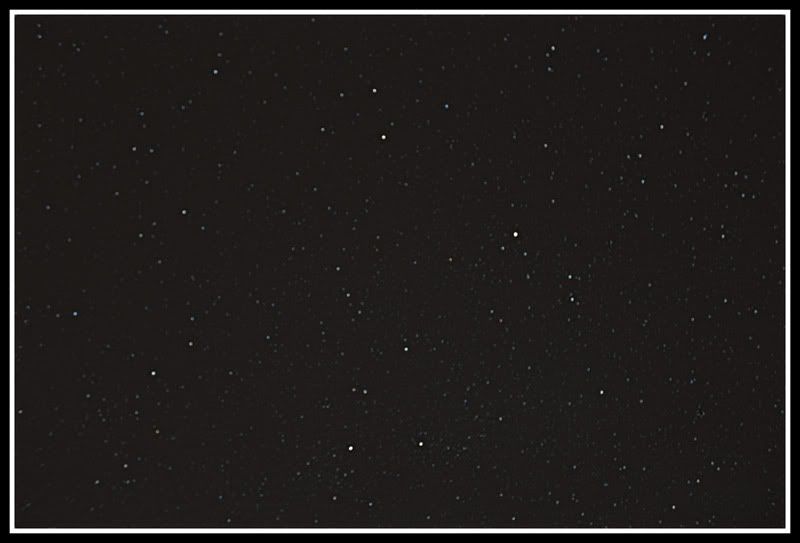
I spotted a couple of satellites pass over whilst I was capturing, but I didn't note the time, so haven't tried to match them up on HA. Then I swapped lenses for the telephoto I now own and pointed the camera at Jupiter, I'd seen a capture done this way on SGL. After mucking with the settings, I finally found the best and captured this
In order from left to right we have :
Callisto, Europa, Jupiter, Io and Ganymede
After I'd processed all these, and was on my way to bed, I spotted a bright glow through the hazed glass on the front door. Grabbing the telephoto lens and camera again, I grabbed a shot of the moon
I love this camera. I also really enjoyed last nights Astro activities. If the weather holds, staying clear, then, as has been suggested by Dangerous_Dave on AC, I'll have a go at capturing more shots of Jupiter and try and animate them. Thanks Dave.
Wednesday, 25 June 2008
Hacked Off
I'm getting hacked off with this weather. It's supposed to be summer, where's the clear skies ? Last night, there was a real doozy of a flare predicted. Mag -7, passing just over Saturn, Mars and Regulus. The clouds had been patchy all day and it looked like I might get away with it. 15 minutes before hand, there was a nice clear patch across the western horizon and I could clearly see Saturn and Mars. I setup the SatCatcher in anticipation. 3 minute before, I dashed out, checked everything, looked up, and right where the flare was due to take place, a monstrous band of thick grey cloud. Gutted.
This morning, before work, I had a little walk, and there in the blue sky was the half moon. Excellent thought I, I'll grab the camera when I get back and get a shot of that. Of course, the clouds had moved in. Through patience and nipping in and out most of the morning, I did manage to get a shot of it.
There's another flare tonight, Mag -0 so nowhere near as dramatic, but also close to Saturn and Mars. I'll see if the clouds can spoil that shot to.
Tuesday, 24 June 2008
Not stacking Mel111
I had a try, well actually quite a few tries, to stack the Mel111 images from last night. My first two attempts crashed out with Memory errors after they had been processing for some time. I couldn't believe it. I tried again after first shutting everything else down and still the same problem. Now I know the RAW files from the 450d are big at 15Mb each, but this is getting silly. I tried again. This time paying more attention to the settings. I'd found I'd set Drizzle x2 on a previous run and not reset it. This stopped the memory errors. That, however then led onto the next problem. It didn't matter what I did, and believe me I tried, DSS would not stack the images. The best I could get was to subtract the darks from the best image. I thought perhaps it was struggling with the number of stars, and I found a setting to change the star detection threshold. This improved things when registering the images and I got more found, but still only 1 image would stack.
I sought help from AC. The pointers given were helpful, but still the same problem. Although, now DSS was telling me it found loads of stars. There's an option to increase the brightness of the RAW files, I used that, and it certainly sorted that out. In the end, I converted all the RAW files to tif's and ran them through registax in case. This was able to stack them ok, bit I ended up with what looked almost like some form of star trail shot.
I'd known that I had a little trailing in the image, but hadn't realised how badly it was going to upset the stacking programs. Neither of them would do what I was trying to get them to do. I then tried to setup some form of processing to remove the star trails, I couldn't even get this to work on a single image. I have now given up on trying to stack them. The best I can manage is the single frame from yesterday. It's a shame, but there we are. A lesson learnt, without too much pain thankfully. Next time, either the camera will be piggy backed on the NexStar mount or use shorter exposures, or less zoom.
Three Legged Flares
A fine night again, although given how late it's getting dark at the moment, not really much opportunity to use the scope, especially with needing to get up for work. Still, I had the possibility of 3 Iridium Flares last night. I setup the 450d on the SatCatcher set at 20 seconds, f5.6 @ISO400, zoomed to 55mm on the kit lens. Manual Focus (I switched off the IS too, not a lot of point tripod mount). Used the 2 second self timer to allow any motion to settle, I don't have a remote yet.
First up Mag -2 Iridium 95. 2234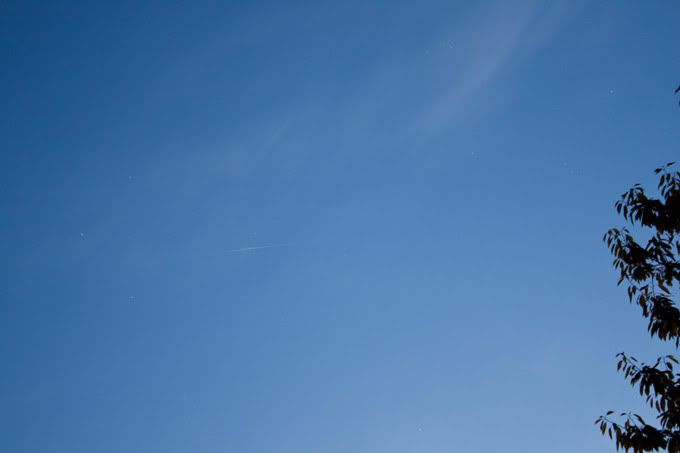
About 15 minutes later Mag -0 Iridium 31 2252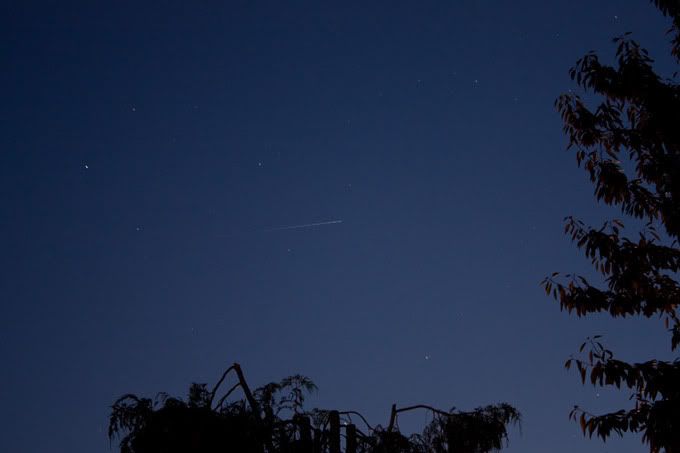
After catching these two, I went back inside as the sky was still bright, and I had some things to finish off. I got back out about 2330 with the SatCatcher and the bins. I setup the camera ready for the next flare at 0009 and had a trawl around the sky with the bins. Again, I felt the astonishment of the quantity of stars that could be seen. As I was panning slowly around, I stumbled across a patch of stars that, despite the odd orientation (been a while since I saw them last) looked like Mel111. So I swung the camera around and snapped off 20, 20 second frames. I'm having some issues with getting DSS to stack the frames and I don't know why. I've managed to get around the memory errors, but now it'll only stack one frame.
Anyway, I ran one frame throught Noels tools LP removal, and this is what came out.
I'm impressed with that for only 20 seconds.
Then as the time was fast approaching for the next and last flare of the night, I set up the SatCatcher and this is what I caught.
Mag -4 Iridium 19 0009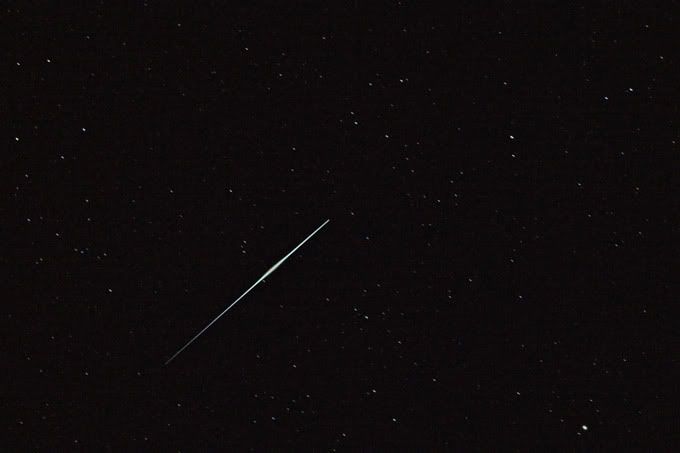
This too was run through Noels LP removal tool. The 450d just does so much of a better job than the Z2. It's a shame as the Z2 is a good camera, but it's gonna have to be relegated to spare status.
Monday, 23 June 2008
Flare, Rocket and wide
I got out for a little while last night. As the sky was getting darker and managed to snag another Flare. Iridium 4 this time (on the 450d).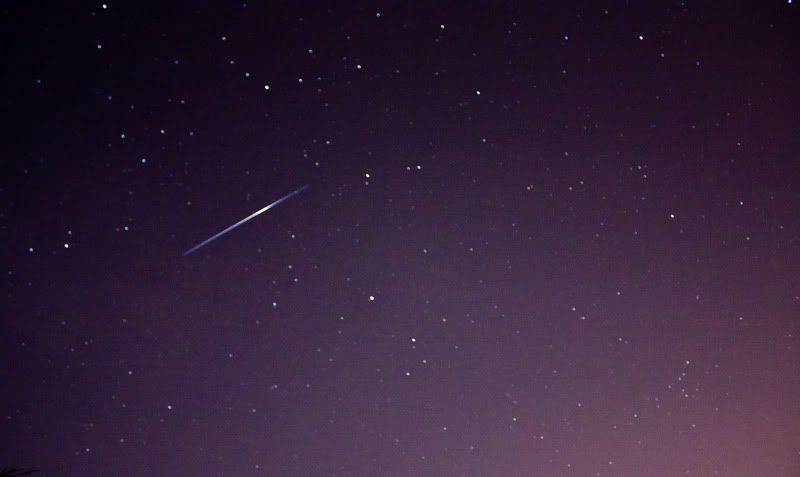
Then I was lining up to take a couple of widefields I saw a faint dot shooting across the sky and managed to snag that to. The image is very noisy but I can't do a lot about that without losing the satellite track. Turns out is was Cosmos 2360 Rocket, although as I'd forgotten I'd set the camera for GMT, I originally thought it was Lacrosse 4.
Then I snapped a few widefields.
Cassie
And these all contain Corona Borealis (I think)



This camera is so much more sensitive than the Z2, it's quite astonishing.
Friday, 20 June 2008
Widefiled with new toy
I got a Canon 450d for my birthday. I got to test it out on a widefield shot last night. Only a couple of gaps between cloud bands, but not enough to warrant getting the scope out. This is a single frame, 60Secs@ISO800 with the kit lens. To get 60 seconds, as I don't have a remote release yet, I had to hold the shutter button for 60 seconds, even on a tripod, this isn't as easy as it sounds. Anyway, this is what came out. There is a plane went through the shot on the left hand side.
Thursday, 12 June 2008
Multi Point Moon Mosaic
After my earlier success with the multpoint stack of the Theophilus region, I had another go at the moon mosaic. This too, once processed using multipoint in Registax appears much finer in detail.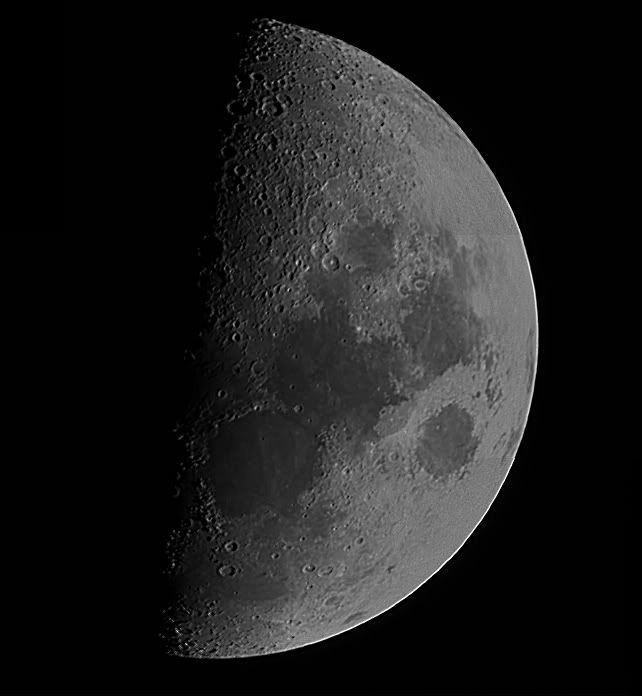
I can't wait to get out and try again. Problem is in typical fashion, the clouds are back with a vengeance.
Reprocessing the Theo AVI again in Multipoint
After many repeated attempts, I finally managed to get Registax 4 to process the AVI's using a multpoint align and not leaving join lines all across the images. The trick was to set feather to a larger number (15). The resulting image, after a play in wavelets and sharpen in PS, to my eyes, is a much "finer/less coarse" image. I let Registax pick the points and process largely without intervention, it chose 51 alignment points and stacked 157 of 1586 frames. This resulted in: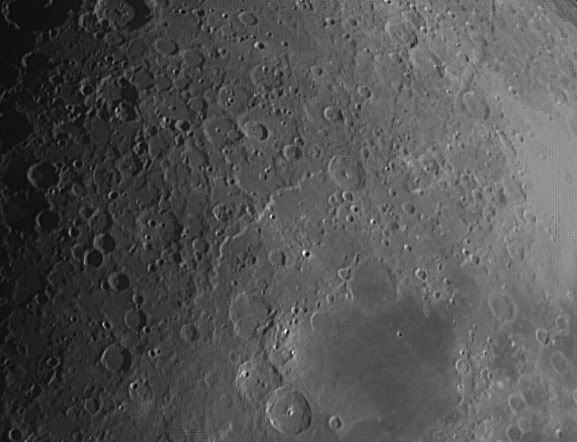
But took oh so much longer to process. Well over 2 hours. Not a problem, as I just left it to get on with it. I'm going to reprocess the 2 pane mosaic later in the same way.
Wednesday, 11 June 2008
Removing the Bayer Matrix
It turns out that the RAW mode files contain the bayer matrix (the grid) still and registax will remove this. Good news. So I reprocessed the original RAW avi's, didn't use AVIRAW and a quick play in PS resulted in
Theo Region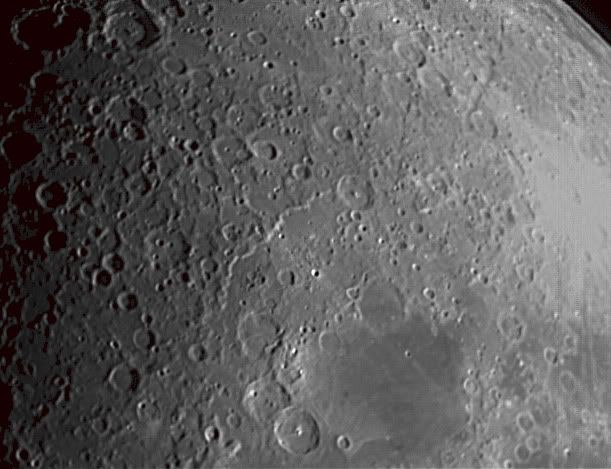
Moon Mosaic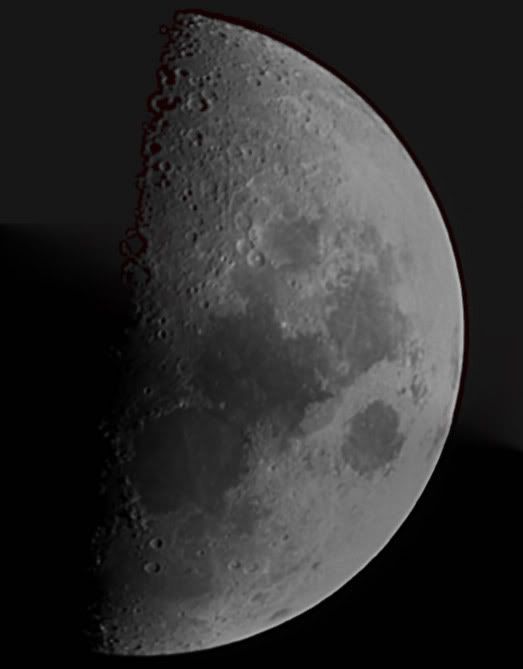
Something didn't quite go according to plan along the top half of that, I need to go and look at it again later.
The Moon and a Flare
Another glorious day, followed by a reasonably clear night. I had a list of 5 Flares to try and catch last night, and I decided I'd setup the scope and have a go with the webcam on the moon again with the flares interspersed in the moon captures.
I set up the SatCatcher. The first flare, after some careful ponderations over it's location proved to be behind a tree in the neighbours garden, I wonder if they'd notice if I took a few branches off here and there ? Probably. Oh well. Mean while I got the scope and gear all setup and was working on getting focus with the webcam in black and white mode, thought it worth a try. Didn't really capture much, just working on trying to achieve focus and see how much the shifter pushes the image around. The second flare came around, my palm went off and I went over and setup the camera. At the correct moment I hit the shutter button, waited, and reviewed the image. Black. Oh no, what's wrong with the camera? No, what's wrong with the operator ? I'd taken a 30 second exposure of the inside of the lens cap, again!!
Back to the scope. I decided I'd have a go with a RAW mod on the webcam. Very easy to do, there's a nice piece of software available that handles all the changes for you. Captured a few AVIs, with a pause to dash over to the SatCather, where I did finally get the settings on the camera right, but the direction was slightly off. I don't think the compass was aligned quite correctly. Need to look into that.
Iridium 3 Mag -2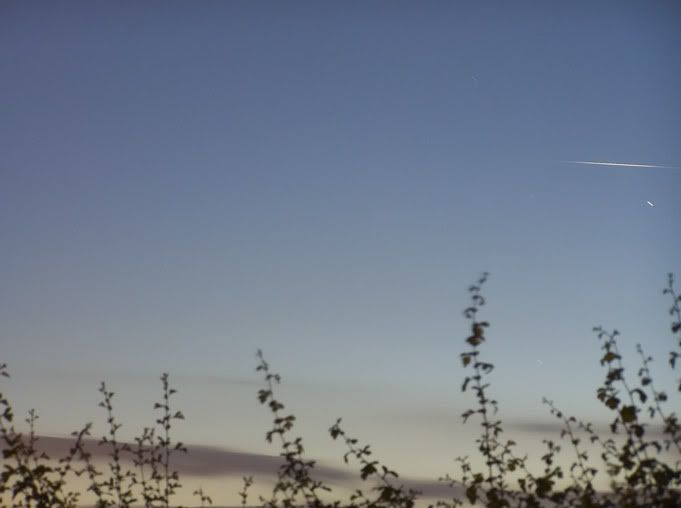
After capturing a bunch of AVI's some at F5 and one at F10 I transfered them to the desktop for processing. Having run them through aviraw, and after several attempts with Multipoint processing in Registax that didn't work as expected, I settled on single point. Here's the results after wavelets and a little PS sharpening. The 2 panel mosaic was constructed in PS as iMerge did odd things with the matrix overlay.
The Theo region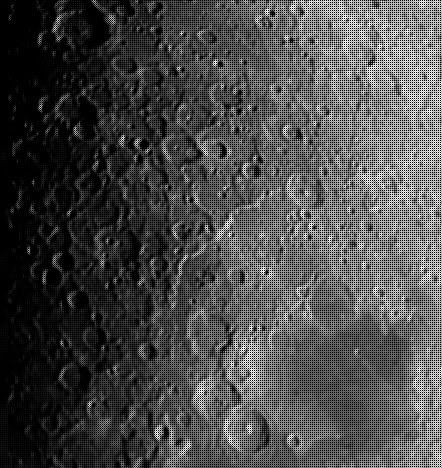
2 Panel mosaic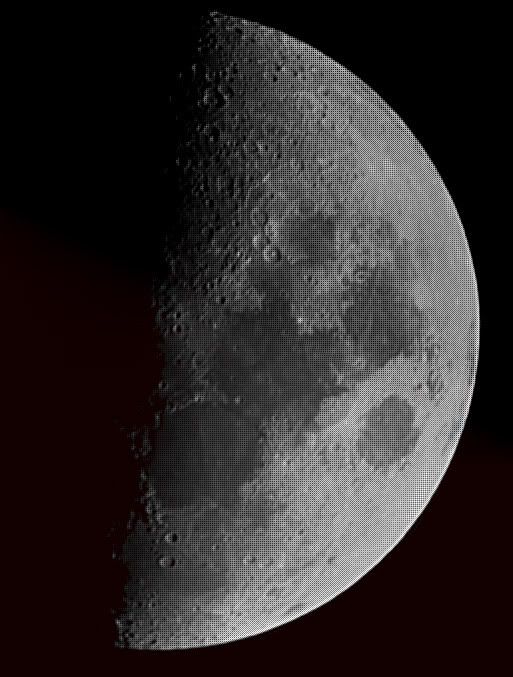
I hope it's clear again tonight so that I can try this with the webcam in colour mode.
Tuesday, 10 June 2008
An almost coloured moon and a Flare
Another brilliant day and clear evening. Worryingly I'm finding myself strangely uninspired. I never bothered to get the scope out, even though the moon was visible all evening. I tried a few shots of the moon, trying to get the Z2 to eek out a little more detail/colour. I'm not convinced, but this is the result
I also only managed to capture the one of two possible Iridium flares. Operator error in this case. I didn't check my watch in time, and was sat indoors.
Iridium 46 Mag -6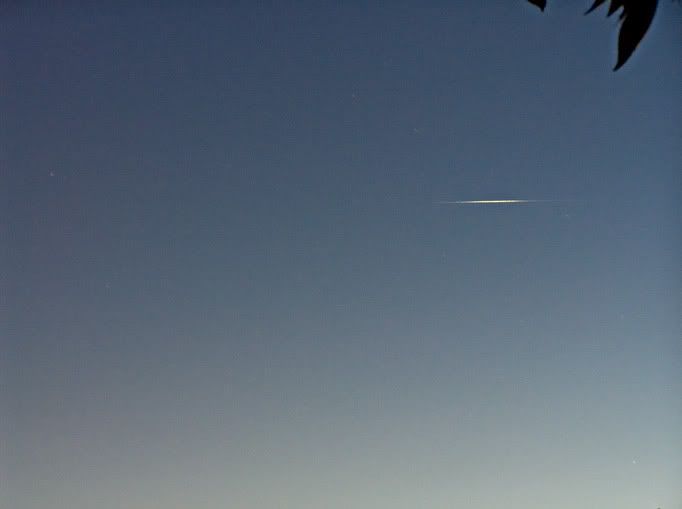
Sunday, 8 June 2008
Moon and Satellites
For a change, after a clear, bright and hot day, the sky also stayed mostly clear with some odd wisps of clouds floating along. As the evening wore on, and the sky got ever so slowly (or so it seemed) darker, the six day old moon showed clearly to the south. About 2130 I grabbed all the gear and went out for a go at webcam imaging. The seeing wasn't great as the images were really quite wobbly. But with some persistence, I was able to capture a number of sequence of AVI's. It turns out upon reviewing them, I hadn't noticed at the time as I was typing away on AC, that during the midst of most of them, some of the cloud had drifted across and obscured the moon sufficiently, that the webcam had captured almost no data. In the end, I through away 6 of 8 of the images. This leaves one image at F10 and one image at F25. Now I'm having some problems stacking them in Registax at the moment, every attempt has ended with lines across the middle of the image, but I'm seeking help, watch this space for when the avi's are finally processed.
The mods I did to the focuser has certainly helped, the movement being much smoother, although at F20 (5x barlow) the image shift is still too severe for effective usage. I have on order a 5yd roll of stickon teflon that I'm going to use to pad out the drawtube and see what difference that makes.
Whilst the avi's were being captured there were also 3 Iridium flares I was keeping an eye out for. I set up the SatCatcher and set the camera to about mid range on the zoom.
Iridium 23 Mag -5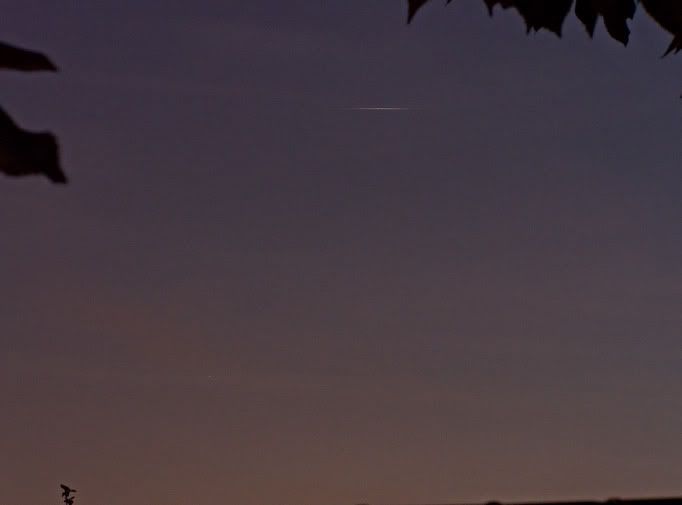
Iridium 76 Mag -0
Then whilst waiting for the next flare, I had a good long look at the region around Piccolomini. An interesting area, with the Piccolomini crater having a small semi circular chain of craters around it in almost a crown shape. I also had a play and comparison between the 2x barlow and the set of fine tuning rings with the 5mm Hyperion. The tuning rings make the ep a 2.5mm Hyperion, so in theory I ought to get the same image scale as using the 5mm with the barlow. Oddly, the image seemed to me, to be slightly larger with the barlow than with the tuning rings.
I looked up during this experimentation and spotted an interesting sight, and I just had to capture it. In the same area of the Sky, the Moon was shining, but nearby was Saturn and Mars and all three were visible. Now how could I not take a picture of it, it would have been rude.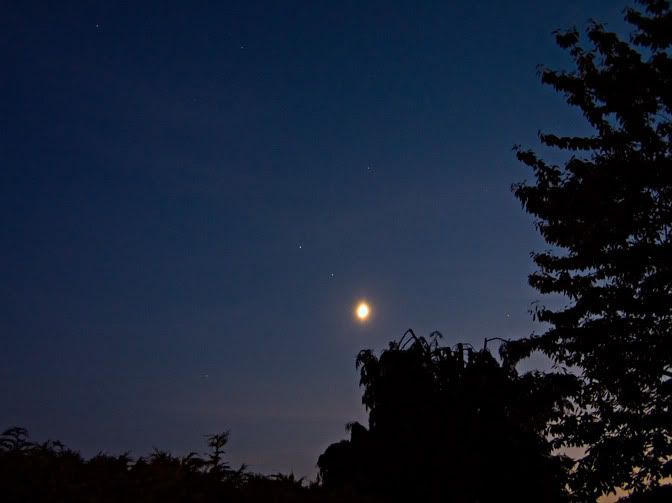
Then it was almost time for the next Iridium, so I realigned the SatCatcher and got :
Iridium 58 Mag -0
I decided I'd have a go at imaging Saturn again, but the focuser really let me down, and I just couldn't get the image. It didn't help that after 10 minutes, the bushes along the edge of the garden started to get in the way. So I started to pack up. Whilst I was doing this, I thought I'd try an experiment about using the main tube itself as a finder. To do this, point a torch in the eyepiece end, and it would project out the Objective. I aligned the scope on a nearby tree and did just that. It worked quite well, but the torch I was using has three LED's in them, and it looked a bit like the Mysterons from Captain Scarlet. So I finished the night with a picture of this, just for the fun of it.
Friday, 6 June 2008
An update on the Focuser
I had a bit more of a play with the focuser last night. I'd seen a post suggesting removing a little of the bottom of the focus bar housing to allow the R&P cogs to mesh properly. As mine had little bits of plastic in there, I removed them. The cogs certainly mesh better, but it hasn't cured the image shift. The next thing to try is to fit some Teflon strips to the drawtube to pack out the drawtube housing and ensure that the drawtube is held properly. Just got to find a source and order some up.
Flares, none last night thank you!!
A nice day all day, and Heavens Above were predicting 2 good flares, Mag -4 and -8. As evening wore on, some cloud started moving in to spoil the view, typical. I setup the SatCatcher anyway on the off chance that the flares might burn through the cloud. The first one at 2238 I managed to take a lovely picture of a cloud bank and no sign of the Flare. The young moon was up and looked rather ethereal in amongst the ribbons of cloud, so I snapped a shot of that to capture the Earthshine.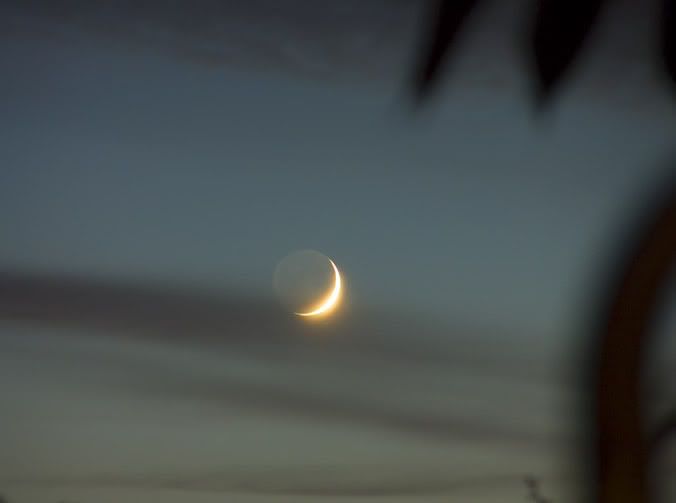
Just over an hour later, I headed back out again for an attempt on the second flare. I got everything setup even though the cloud was much heavier, double and triple checked all the bearings and exposure settings on the SatCatcher. Triggered the shutter on the offchance, the flare just managed to burn through at it's brightest for about 2 seconds, which I did see. The camera stopped the exposure after 30 seconds, and I checked to see what I'd caught. Nothing, the screen was blank. Damn, what had gone wrong with the camera. I checked, all looked ok, then I realised, I'd left the damn lens cap on, ARRGHH!!!. I'm not to disappointed as the flare was pretty dismal thanks to the clouds, but if I'd done this on a clear night, that would be a different kettle of fish.
Another in the note to self category, when checking the setup is good, make sure the aperture is clear of caps and obstructions.
Thursday, 5 June 2008
Attempting to fix the focus shitfer
Thanks to high25 from AC, for the Silicone lubricant, I decided I'd have a regrease of the focuser and see if I could do anything about the image shift when I try to focus. Ok, first off, remove the focuser from the OTA, figured this was a good idea, as I didn't want to get anything on the lens. I promptly dropped the first fitting screw for the focuser and looked on helplessly as it bounced and rolled under the cupboard, I really should have had a tray or something underneath, 20x20 hindsight is a wonderful thing. Anyway, after judicious use of various tools, implements and torches I did, thankfully manage to retrieve it. I moved away from where I was and put something underneath to catch anything else I might drop.
Once all was dismantled, I managed to clean all the greyish gunk that felt more like superglue than lube that was all over the focuser with application of cloth, toothbrush and wd40. Of course it got everywhere and I spent the next few minutes trying to wash this stuff off. Then using a bradawl I applied the silicon stuff and had a look to see if I could work out what was causing the image shift.
By a process of experimentation, I narrowed it down to a slight shift in the drawtube when the focus knob is turned in the opposite direction from previously (Backlash??). I applied strips of sticky back plastic along the drawtube where the felt runners are in the focuser itself. Not enough. What else can I do ? I added a piece of cardboard, folded several times and a spot of glue to hold it in place under the gear at the front of the drawtube. All these steps appear to have helped somewhat, but I won't really know by how much until I can test it out properly, oh and the focuser is much smoother to use to now.
Wednesday, 4 June 2008
ISS, Iridium 26, some Satellites and Bin staring
Finally after what seems like weeks of cloudy nights, it's odd that it seems to be so overly long between gaps, the sky was clear last night. It didn't get dark, proper dark till really late though. I'd never noticed before how late the sky finally gets dark in the summer months. I guess the longest day is only just around the corner.
I checked on HA for pass details on the ISS and for Iridium Flares. A couple of reasonable if low passes to catch. So as time ticker on towards 2200, I got setup for the first go of the night, the ISS. I set up the SatCatcher and aligned on the Alt and Az bearings. I snapped a couple of test shots, as the sky was just so bright still, for taking 15 second exposures and ended up setting the aperture closed down. On cue, I could see the ISS skating across the sky, no up and over for the speedster tonight. I fired the shutter at the right time, then about 5 seconds into the shot, nudged the tripod, only a little, and I'd hoped I got away with it, but no. Blast it (that wasn't what really came out, but I can't use that on here).
The unedited disaster (I spose as disasters go this is pretty mild really ;o)):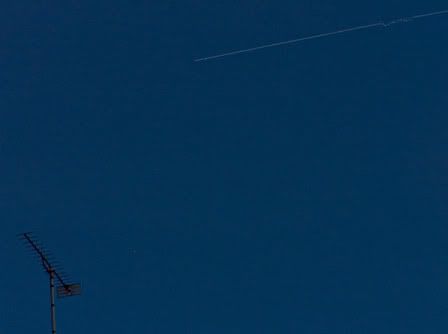
Then I used some of the skills I've picked up over the past few months with PS to "adjust" the image to make the path correct: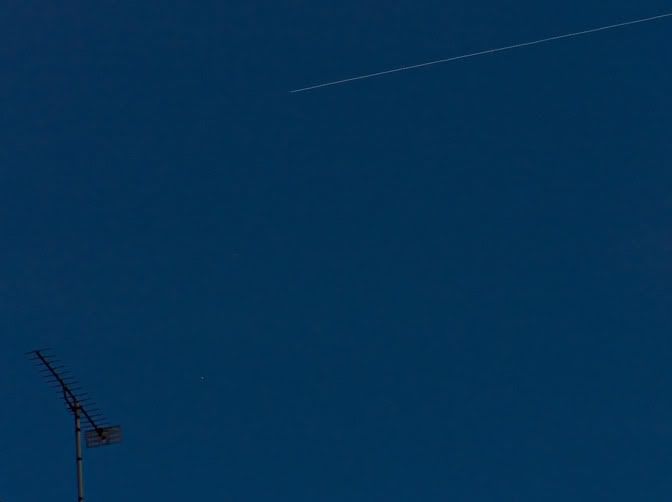
At least I got a usable image out of it. Still over 40 minutes till the Flare and the sky was too bright to really see much as yet, so after aligning the SatCatcher, I popped in for a while leaving the setup ready for the flare. For some reason, when I came back to it, the camera wouldn't awaken from it's sleep. Never done that before. Anyway, I ended up having to power off and on the camera again. This of course reset a couple of things. So after setting the focus point and checking the format, I was ready to go or so I thought. I didn't check/reset the zoom, so instead of zooming about 60% as I'd planned the camera was on it's widest setting. I also forget to reset the aperture to it's most open and the camera tried to compensate but it made the image really very noisy. After some swearing and editing in PS I ended up with this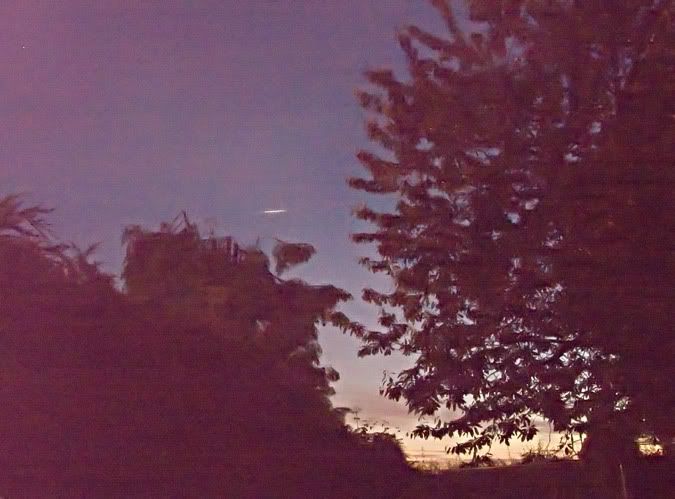
I caught it but not as I'd wanted to. Oh Well.
Than I collected the Bins, had a look on Stellarium for the Bin objects on the list that I'd found for June, made some non detailed instructions on how to find them and headed out again. First off I tried to locate Mel 111 as a reference point. Hmm, having some trouble here. Whilst hunting around, I noticed a little dot moving across the sky, it was in the west and heading from South to North, checking HA this was Cosmos 1703.
I gave up on Mel111 for a while, let's be honest, my eyes had hardly adapted properly as yet, so I spent the time as productively as possible trying to locate constellations. I could only positvely identify 5 that I haven't seen before, Virgo, Crater, Corvus, Lyra and Cygnus. I know there are others, but due to my viewing position, and no sign of the eastern sky, the house is in the way, I couldn't see them at all. This all took a while as I was struggling with my bearings as everything has moved on so far.
Afterwards I went back to the Mel111 hunt. Whilst I was looking, there's another one. This dot was really rather dim, to the point I could only see it in the bins. So it was pure luck that I even caught this one at all. A check on HA showed it to be SeaSat 1. Yet moments later, and there's another one, this one was Terra. Then my eyes now adjusted, I started finding things. Firstly M5, it's hard to see Globular clusters in bins, but I'm pretty sure that's what I found. By comparison to the stars nearby this was a faint blob in about the correct location. Then I found Mel111, ah that's better. I think Mel111 is my favourite cluster at this time of the year, although there's a few more waiting in the wings, hiding behind the house, that I haven't seen as yet. Then onto M3, using Mel111 and the corner star of Coma Berinices to locate it. Then two more Satellites passed across the sky. I haven't been able to find these, both at approx 2310, one in the North heading North, the other in the West heading West to East.
Then, I guess I got lost in the starfields whilst looking for my next target. I forgot about looking for the objects that I'd noted (although it must be said, that a number of them were too far to the east and therefore hiding behind the house) and had one of those Wow!!! moments as I realised again exactly how many dim pinpoints of light are hiding away up there just out of reach of sight.
After about 30 minutes of swinging the bins around just looking, I came in as I was getting cold. I'd only popped out in a fleece over the top of my clothes (before anyone makes any funny comments!! yes you know who you are...), not thinking about putting on the full winter gear as it's summer right ?
The gremlins were out in force tonight, thankfully nothing except my intentions was broken and I was able to fix one of the problems caused with some judicious use of the clone tool in PS.
There was, however, one final surprise to come. I was awoken at about 0330 this morning by work, and once I'd finished on the call, as the sky was still clear, I popped out to see what was about. There in the South East, was a surprisingly bright spot. I fired up the computer to confirm my suspicions, and I was correct, it was the king of the planets. I quick look in bins proved this to be the case, although Jupiter only resolved as a small ball. As I wasn't expecting to be out long, I didn't grab the Vista80sLT, but dismounted the OTA and bolted it on top of it's original camera tripod for a very quick grab and go session. After not leveling or aligning, but just plonking down, it's amazing how much faster to set up this is, I pointed the scope at Jupiter and had a look with the 5mm Hyperion and the x2 barlow for x160. There he was, proud as could be, two bands clearly visible and 4 of his entourage clearly visible. I've worked out these are, on one side, Europa, close in on the opposite side Ganymede, a little further out Io and a long way out Callisto. I'm really glad I had a look. At some point, later in the year, I'm going to point the scope this way again and see what sort of image I can capture with the webcam.
I look forward to more nights out under the stars, in the not too distant future.
Monday, 2 June 2008
Where have all the skies gone ?
Despite Heavens Above providing some predictions for some really good flares and ISS passes, the clouds have not parted for a few days now. No observing, no chance to use the SatCatcher ah well...






